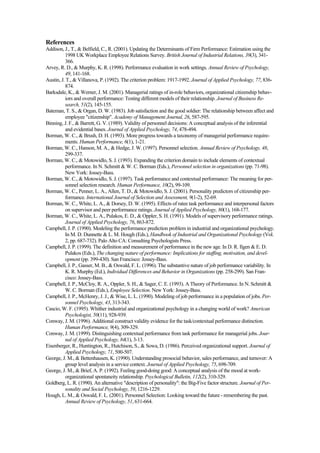This document discusses new models of employee performance and their implications for employment relations. It summarizes two prominent models of performance - a task performance and citizenship performance model proposed by Borman and Motowidlo, and an eight-component model proposed by Campbell. Both models attempt to identify broad dimensions of performance that allow for greater generalizability across jobs and occupations. The document argues that citizenship performance, which involves maintaining the interpersonal environment, contributes significantly to overall performance ratings and organizational outcomes, though it has received less attention than task performance.




![Generally speaking task performance has been seen as role prescribed (Katz & Kahn,
1978) while citizenship performance has been considered discretionary. In comparison to
Campbell et al’s (1996) model task performance includes job-specific and non-job specific
task proficiency as well as aspects of written and oral communication, supervision and leader-
ship, as well as management and administration. Citizenship performance includes much of
the behaviour which makes up Campbell et al’s other dimensions (Motowidlo & Van Scotter,
1994). Both Borman and Motowidlo (1997) and Campbell et al (1996) freely acknowledge
the strengths of each other’s models and the limitations of their own and suggest that despite
their different origins these should be seen as complementary models rather than competitive
ones. Contextual or citizenship activities can be distinguished from task activities in that con-
textual activities support the context or environment within which the technical core of the
organisation must function, rather than supporting the technical core itself. The emphasis is
on the initiative, support and persistence shown rather than the technical proficiency demon-
strated.
Although Borman and Motowidlo (1993) originally referred to citizenship performance as
contextual performance, Borman et al (2001) changed the term to reflect the concept’s rela-
tionship to an earlier notion, organisational citizenship behaviour (OCB), which was initially
described as a category of performance by Smith, Organ and Near (1983). OCB was identi-
fied as reflecting one of three categories of essential employee behaviour identified by Katz
(1964), namely innovative and spontaneous behaviours which are not formally directed or
prescribed1
. OCB has been defined as ‘contributions [which are] not contractually rewarded
nor practically enforceable by supervision or a job description’ (Konovsky & Organ, 1996:
p253); in other words they are behaviours which do not form an official part of a job-role but
which are valued by the organisation nonetheless. However, although OCB’s have repeatedly
been identified as extra-role, both in theoretical discussions and in empirical research
(Barksdale & Werner, 2001; Williams & Anderson, 1991), Organ (1997) stated that it is of
little theoretical or predictive value to insist on this.
Smith et al (1983) and several other researchers (Organ & Konovsky, 1989; Shore &
Wayne, 1993) conceived of OCB as having two dimensions – altruism and conscientiousness
– although subsequent authors have identified as many as five sub-factors: altruism, courtesy,
sportsmanship, generalised compliance, and civic virtue (eg Konovsky & Organ, 1996). OCB
altruism has been equated with citizenship performance towards individuals and OCB consci-
entiousness as citizenship performance towards the organisation generally (Borman & Mo-
towidlo, 1993; Borman et al., 2001), although others have considered OCB conscientiousness
to more of a motivational or attitudinal variable (Organ & Ryan, 1995). Similar dimensions
have been used in research conducted under the banner of contextual performance, namely
interpersonal facilitation and job dedication (Van Scotter & Motowidlo, 1996). Interpersonal
facilitation refers to behaviours which contribute to organisational outcomes through interper-
sonal means. It includes altruism (Smith et al., 1983), helping coworkers (George & Brief,
1992) as well as a range of other behaviours which address issues such as barriers to perform-
ance, morale and cooperation (Van Scotter & Motowidlo, 1996). Job dedication is more
closely linked to Smith et al’s (1983) original dimension of generalised compliance which has
also been labelled conscientiousness, and includes performance behaviours such as self-
discipline, rule-following, and taking initiative (Van Scotter & Motowidlo, 1996).
1
Interestingly of the other two categories of essential employee behaviour identified by Katz, the first
one, entering and remaining within the organisation, although a significant organisational variable would
not be commonly considered a form of performance per se, while the second, carrying out one’s role re-
liably, echoes Borman and Motowidlo’s (1993) dimension of technical or task performance.](https://image.slidesharecdn.com/modelperformance-150921093020-lva1-app6892/85/Model-performance-5-320.jpg)





